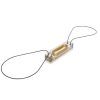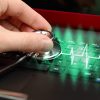A study from Microsoft Research, published in the July 2022 IEEE Journal of Biomedical and Health Informatics, highlighted to need for more demographically diverse populations and challenging evaluation settings when performing blood pressure (BP) estimation studies, and identified tonometry-derived features as the most accurate measures for cuffless BP monitoring.
Rebecca Mieloszyk, et al, measured the BP of 1,125 subjects (aged 21-85, 49.2% female, multiple hypertensive categories) in-lab over a 24-hour period with a subset also receiving ambulatory measurements.
They collected radial tonometry, photoplethysmography (PPG), electrocardiography (ECG) and accelerometry signals simultaneously with auscultatory or oscillometric references for systolic (SBP) and diastolic blood pressure (DBP). They evaluated predictive models to estimate BP using a variety of sensor-based feature groups against challenging baselines.
The researchers found that tonometry-derived features showed superior performance compared to other feature groups and baselines, yielding prediction errors of 0.32±9.8 mmHg SBP and 0.54±7.7 mmHg DBP in-lab, and 0.86±8.7 mmHg SBP and 0.75±5.9 mmHg DBP for 24-hour averages.
Younger and normotensive subjects had the most consistent readings across all feature groups and showed the lowest SBP error standard deviation (SD). SBP SD was further reduced 15–20% when constrained to the calibration posture alone. Reference type, posture relative to calibration and controlled vs. ambulatory setting all significantly impacted BP errors.
Based on these findings, the authors concluded that there is a need for more demographically diverse populations and challenging evaluation settings for BP estimation studies.







